2005 SUBARU FORESTER brakes
[x] Cancel search: brakesPage 289 of 477

7-32
Starting and operating
trols each brake through the ABS, whenever the ABS
stops operating due to a malfunction in that electrical
system, the Vehicle Dynamics Control will also be-
come unable to control all four brakes. Thus Vehicle
Dynamics Control system operation halts and the
warning light turns on. Although both the Vehicle Dy-
namics Control system and the ABS will be inoperable
in this situation, it will still be possible to stop the vehi-
cle using normal braking. The Vehicle Dynamics Con-
trol system and the ABS do not adversely affect oper-
ation of the vehicle in any way when they are inopera-
ble; however should such a situation occur, drive with
care and have an authorized SUBARU dealer carry
out an inspection of those systems at the first available
opportunity.
NOTE
When the warning light turns on and off in the fol-
lowing way, it indicates that the Vehicle Dynamics
Control system is operating normally. �y
Although turning on after the engine has been
started, the warning light quickly turns off and
stays off. �y The warning light turns on when the vehicle is
being driven; it then turns off and stays off. �V Vehicle Dynamics Control OFF indicator light
This light comes on to indicate that the Vehicle Dy- namics Control system is in non-operation mode. This
does not constitute failure of the Vehicle DynamicsControl system.
NOTE �y
The indicator light may stay on for a while after
the engine has been started, especially in cold
weather. This occurs because the engine has not
yet warmed up and is completely normal. The light
will turn off when the engine has reached a suit-
able operating temperature. �y When an engine problem occurs and the mal-
function indicator lamp turns on, the indicator
light will also come on.
The following two situations could indicate malfunction
of the Vehicle Dynamics Control system; if either
should occur, have an authorized SUBARU dealer
carry out an inspection of that system at the first avail-
able opportunity. �y The indicator light does not turn on when the ignition
key is turned to the ON position. �y The indicator light fails to turn off after the engine is
started, even when several minutes have passed to al-
low the engine to heat up sufficiently.
Page 309 of 477

8-8
Driving tips
Off road driving
Because of the AWD feature and higher ground clear-
ance, your SUBARU can be driven on ordinary roads
or off-road. But please keep in mind that an AWD
SUBARU is a passenger car and is neither a conven-
tional off-road vehicle nor an all-terrain vehicle. If you
do take your SUBARU off-road, certain common
sense precautions such as the following should be taken: �y
Make certain that you and all of your passengers
are wearing seatbelts. �y Carry some emergency equipment, such as a tow-
ing rope or chain, a shovel, wheel blocks, first aid kit
and cell phone or citizens band radio. �y Drive carefully. Do not take unnecessary risks by
driving in dangerous areas or over rough terrain.�y Slow down and employ extra caution at all times.
When driving off-road, you will not have the benefit of
marked traffic lanes, banked curves, traffic signs and
the like. �y Do not drive across steep slopes. Instead, drive ei-
ther straight up or straight down the slopes. A vehicle
can much more easily tip over sideways than it can
end over end. Avoid driving straight up or down slopes
that are too steep.�y Avoid sharp turning maneuvers, especially at higher speeds. �y
Do not grip the inside or spokes of the steering
wheel. A bad bump could jerk the wheel and injure
your hands. Instead drive with your fingers and
thumbs on the outside of the rim.�y If driving through water, such as when crossing
shallow streams, first check the depth of the water and
the bottom of the stream bed for firmness and ensure
that the bed of the stream is flat. Drive slowly and com-
pletely through the stream. The water should be shal-
low enough that it does not reach the vehicle’s under-
carriage. Water entering the engine air intake or the
exhaust pipe or water splashing onto electrical parts
may damage your vehicle and may cause it to stall.
Never attempt to drive through rushing water; regard-
less of its depth, it can wash away the ground from un-
der your tires, resulting in possible loss of traction and
even vehicle rollover. �y Always check your brakes for effectiveness immedi-
ately after driving in sand, mud or water. Do this by
driving slowly and stepping on the brake pedal. Re-
peat that process several times to dry out the brake
discs and brake pads.�y Do not drive or park over or near flammable materi-
als such as dry grass or fallen leaves, as they may
burn easily. The exhaust system is very hot while the
engine is running and right after the engine stops. This
Page 312 of 477
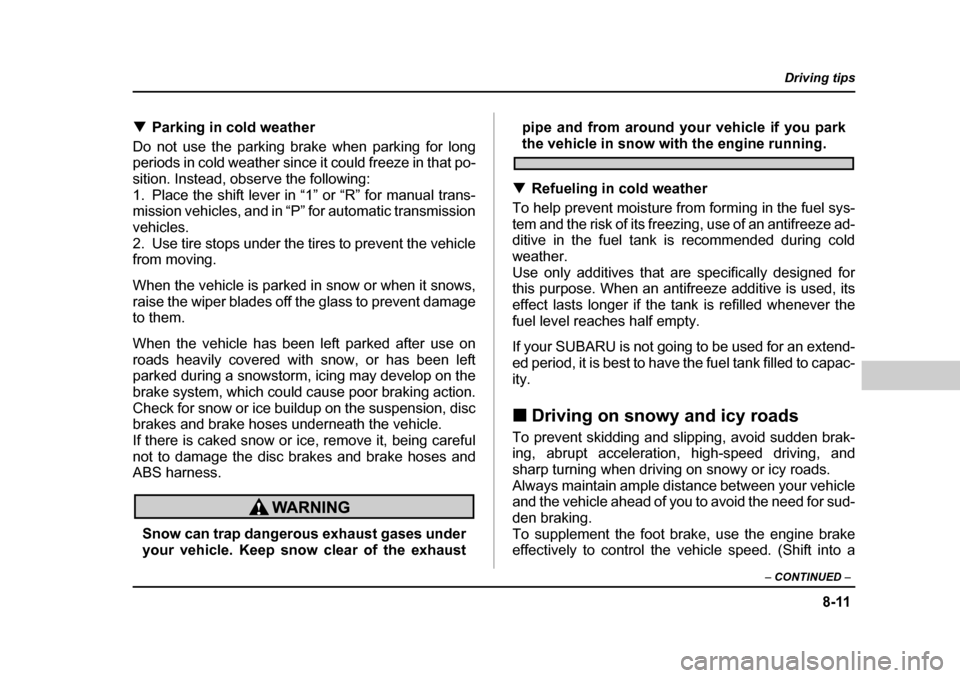
8-11
Driving tips
– CONTINUED –
�TParking in cold weather
Do not use the parking brake when parking for long
periods in cold weather since it could freeze in that po-
sition. Instead, observe the following:
1. Place the shift lever in “1” or “R” for manual trans-
mission vehicles, and in “P” for automatic transmissionvehicles.
2. Use tire stops under the tires to prevent the vehicle
from moving.
When the vehicle is parked in snow or when it snows,
raise the wiper blades off the glass to prevent damage to them.
When the vehicle has been left parked after use on
roads heavily covered with snow, or has been left
parked during a snowstorm, icing may develop on the
brake system, which could cause poor braking action.
Check for snow or ice buildup on the suspension, disc
brakes and brake hoses underneath the vehicle.
If there is caked snow or ice, remove it, being careful
not to damage the disc brakes and brake hoses and ABS harness.
Snow can trap dangerous exhaust gases under
your vehicle. Keep snow clear of the exhaust pipe and from around your vehicle if you park
the vehicle in snow with the engine running.
�T Refueling in cold weather
To help prevent moisture from forming in the fuel sys-
tem and the risk of its freezing, use of an antifreeze ad-
ditive in the fuel tank is recommended during cold
weather.
Use only additives that are specifically designed for
this purpose. When an antifreeze additive is used, its
effect lasts longer if the tank is refilled whenever the
fuel level reaches half empty.
If your SUBARU is not going to be used for an extend-
ed period, it is best to have the fuel tank filled to capac- ity. �„ Driving on snowy and icy roads
To prevent skidding and slipping, avoid sudden brak-
ing, abrupt acceleration, high-speed driving, and
sharp turning when driving on snowy or icy roads.
Always maintain ample distance between your vehicle
and the vehicle ahead of you to avoid the need for sud-
den braking.
To supplement the foot brake, use the engine brake
effectively to control the vehicle speed. (Shift into a
Page 323 of 477
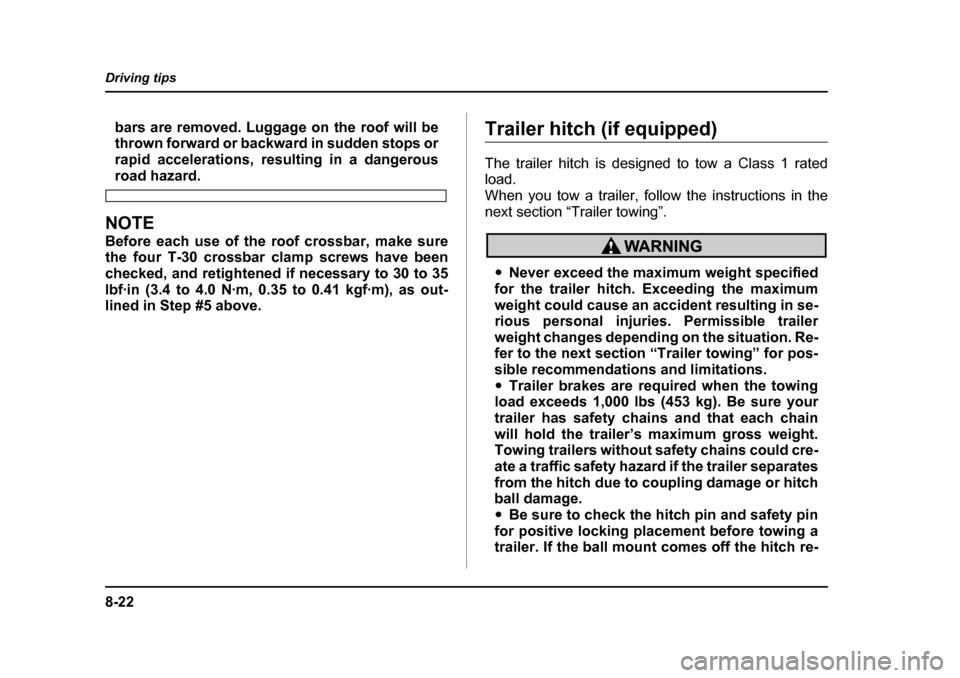
8-22
Driving tips
bars are removed. Luggage on the roof will be
thrown forward or backward in sudden stops or
rapid accelerations, resulting in a dangerous
road hazard.
NOTE
Before each use of the roof crossbar, make sure
the four T-30 crossbar clamp screws have been
checked, and retightened if necessary to 30 to 35
lbf·in (3.4 to 4.0 N·m, 0.35 to 0.41 kgf·m), as out-
lined in Step #5 above.
Trailer hitch (if equipped)
The trailer hitch is designed to tow a Class 1 rated
load.
When you tow a trailer, follow the instructions in the
next section “Trailer towing”.
�y
Never exceed the maximum weight specified
for the trailer hitch. Exceeding the maximum
weight could cause an accident resulting in se-
rious personal injuries. Permissible trailer
weight changes depending on the situation. Re-
fer to the next section “Trailer towing” for pos-
sible recommendations and limitations.�y Trailer brakes are required when the towing
load exceeds 1,000 lbs (453 kg). Be sure your
trailer has safety chains and that each chain
will hold the trailer’s maximum gross weight.
Towing trailers without safety chains could cre-
ate a traffic safety hazard if the trailer separates
from the hitch due to coupling damage or hitch
ball damage. �y Be sure to check the hitch pin and safety pin
for positive locking placement before towing a
trailer. If the ball mount comes off the hitch re-
Page 326 of 477

8-25
Driving tips
– CONTINUED –
NOTE
Always disconnect the trailer wire harness before
launching or retrieving a watercraft. �„When you do not tow a trailer
�y Remove the ball mount from the hitch receiver tube
and insert the receiver cover onto the hitch receiver tube. �y Place the dust cap over the fou-pin connector of the
hitch wire harness to protect against possible damage. �y Occasionally lubricate terminals of the four-pin con-
nector using terminal grease.Trailer towing
Your vehicle is designed and intended to be used pri-
marily as a passenger-carrying vehicle. Towing a trail-
er puts additional loads on your vehicle’s engine, driv-
etrain, brakes, tires and suspension and has an ad-
verse effect on fuel economy.
If you do decide to tow a trailer, your safety and satis-
faction depend upon proper use of correct equipment
and cautious operation of your vehicle. Seek the ad-
vice of your SUBARU dealer to assist you in purchas-
ing a hitch and other necessary towing equipment ap-
propriate for your vehicle. In addition, be sure to follow
the instructions on correct installation and use provid-
ed by the trailer and other towing equipment manufac- turers.
SUBARU assumes no responsibility for injuries or ve-
hicle damage that result from trailer towing equipment,
or from any errors or omissions in the instructions ac-
companying such equipment or for your failure to fol-
low the proper instructions. �„ Warranties and maintenance
SUBARU warranties do not apply to vehicle damage
or malfunction caused by trailer towing. If you use your
vehicle to tow a trailer, more frequent maintenance will
be required due to the additional load. (Refer to “Main-
Page 327 of 477
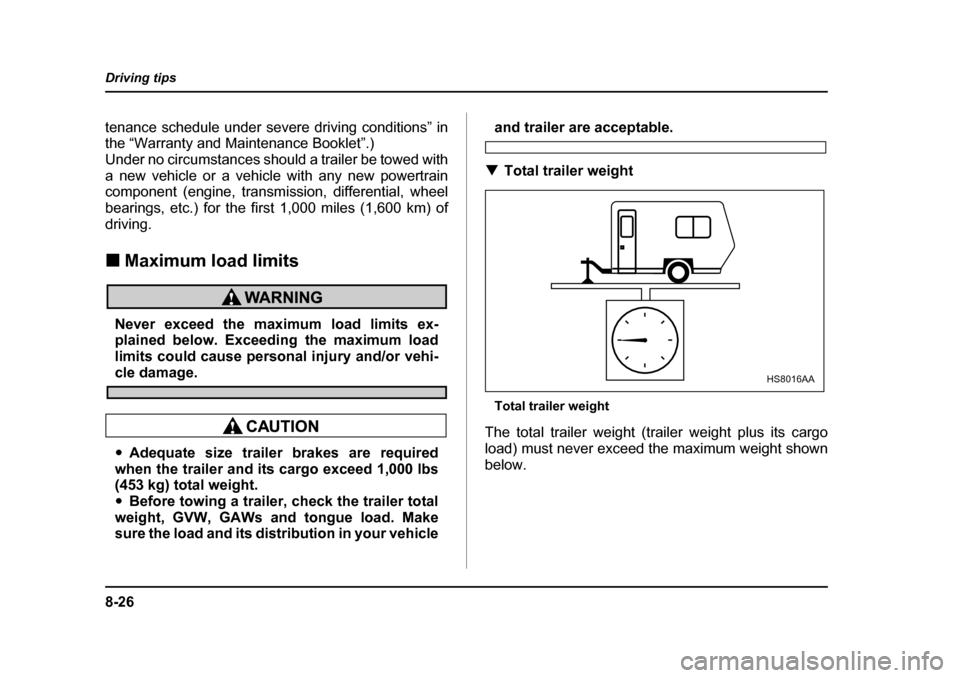
8-26
Driving tips
tenance schedule under severe driving conditions” in
the “Warranty and Maintenance Booklet”.)
Under no circumstances should a trailer be towed with
a new vehicle or a vehicle with any new powertrain
component (engine, transmission, differential, wheel
bearings, etc.) for the first 1,000 miles (1,600 km) of
driving. �„
Maximum load limits
Never exceed the maximum load limits ex-
plained below. Exceeding the maximum load
limits could cause personal injury and/or vehi-
cle damage.
�yAdequate size trailer brakes are required
when the trailer and its cargo exceed 1,000 lbs
(453 kg) total weight. �y Before towing a trailer, check the trailer total
weight, GVW, GAWs and tongue load. Make
sure the load and its distribution in your vehicle
and trailer are acceptable.
�T Total trailer weight
Total trailer weight
The total trailer weight (trailer weight plus its cargo
load) must never exceed the maximum weight shown
below.
HS8016AA
Page 328 of 477
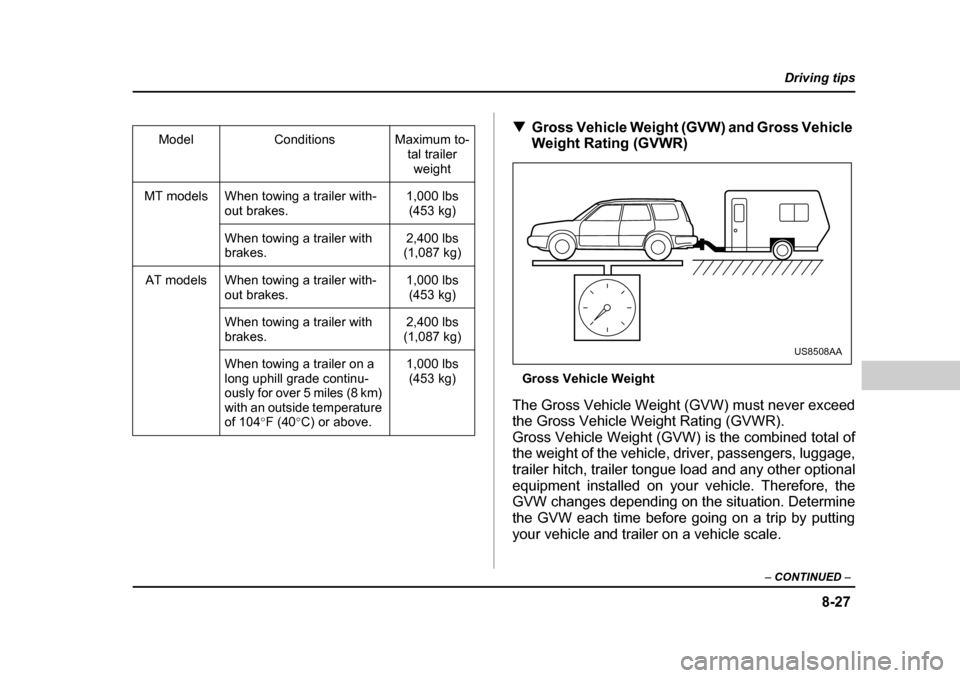
8-27
Driving tips
– CONTINUED –
�TGross Vehicle Weight (GVW) and Gross Vehicle
Weight Rating (GVWR)
Gross Vehicle Weight
The Gross Vehicle Weight (GVW) must never exceed
the Gross Vehicle Weight Rating (GVWR).
Gross Vehicle Weight (GVW) is the combined total of
the weight of the vehicle, driver, passengers, luggage,
trailer hitch, trailer tongue load and any other optional
equipment installed on your vehicle. Therefore, the
GVW changes depending on the situation. Determine
the GVW each time before going on a trip by putting
your vehicle and trailer on a vehicle scale.
Model Conditions Maximum to-
tal trailer weight
MT models When towing a trailer with- out brakes. 1,000 lbs
(453 kg)
When towing a trailer with
brakes. 2,400 lbs
(1,087 kg)
AT models When towing a trailer with- out brakes. 1,000 lbs
(453 kg)
When towing a trailer with
brakes. 2,400 lbs
(1,087 kg)
When towing a trailer on a
long uphill grade continu-
ously for over 5 miles (8 km)
with an outside temperature
of 104 °F (40 °C) or above. 1,000 lbs
(453 kg)
US8508AA
Page 332 of 477
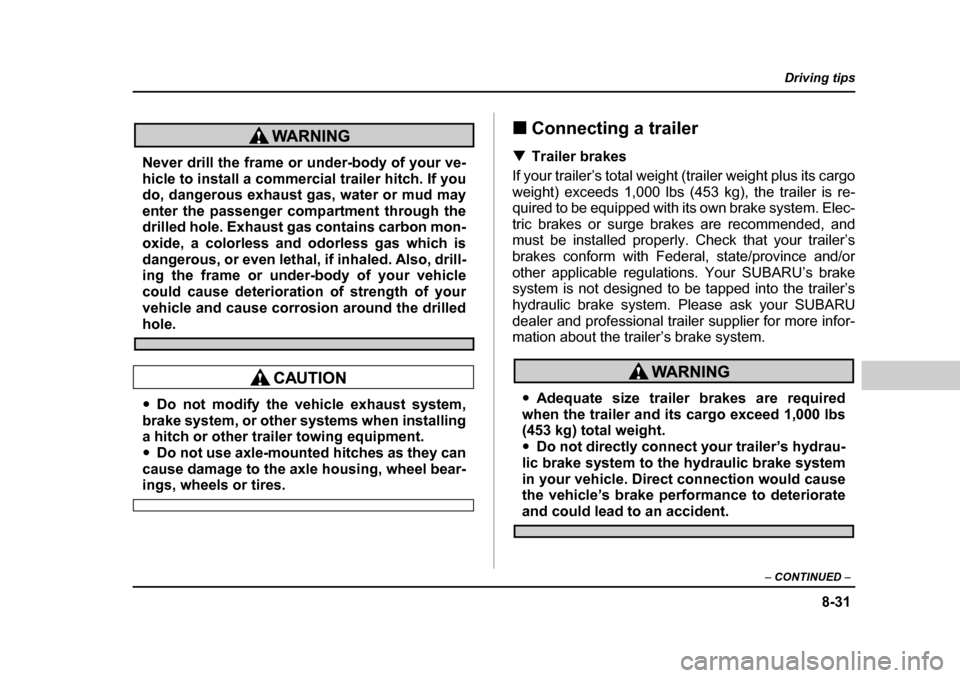
8-31
Driving tips
– CONTINUED –
Never drill the frame or under-body of your ve-
hicle to install a commercial trailer hitch. If you
do, dangerous exhaust gas, water or mud may
enter the passenger compartment through the
drilled hole. Exhaust gas contains carbon mon-
oxide, a colorless and odorless gas which is
dangerous, or even lethal, if inhaled. Also, drill-
ing the frame or under-body of your vehicle
could cause deterioration of strength of your
vehicle and cause corrosion around the drilled
hole.
�yDo not modify the vehicle exhaust system,
brake system, or other systems when installing
a hitch or other trailer towing equipment. �y Do not use axle-mounted hitches as they can
cause damage to the axle housing, wheel bear-
ings, wheels or tires. �„
Connecting a trailer
�T Trailer brakes
If your trailer’s total weight (trailer weight plus its cargo
weight) exceeds 1,000 lbs (453 kg), the trailer is re-
quired to be equipped with its own brake system. Elec-
tric brakes or surge brakes are recommended, and
must be installed properly. Check that your trailer’s
brakes conform with Federal, state/province and/or
other applicable regulations. Your SUBARU’s brake
system is not designed to be tapped into the trailer’s
hydraulic brake system. Please ask your SUBARU
dealer and professional trailer supplier for more infor-
mation about the trailer’s brake system.
�y Adequate size trailer brakes are required
when the trailer and its cargo exceed 1,000 lbs
(453 kg) total weight.�y Do not directly connect your trailer’s hydrau-
lic brake system to the hydraulic brake system
in your vehicle. Direct connection would cause
the vehicle’s brake performance to deteriorate
and could lead to an accident.